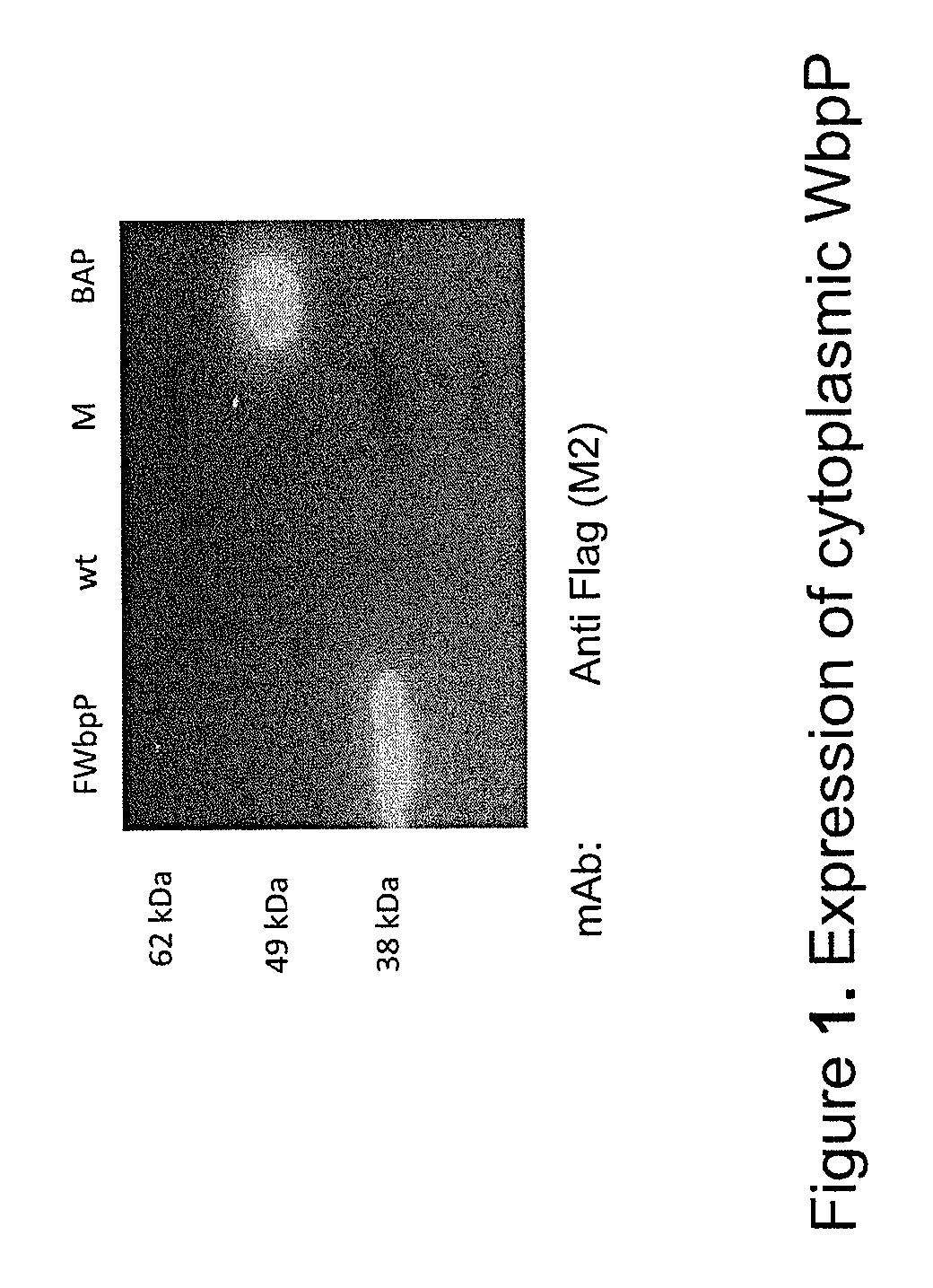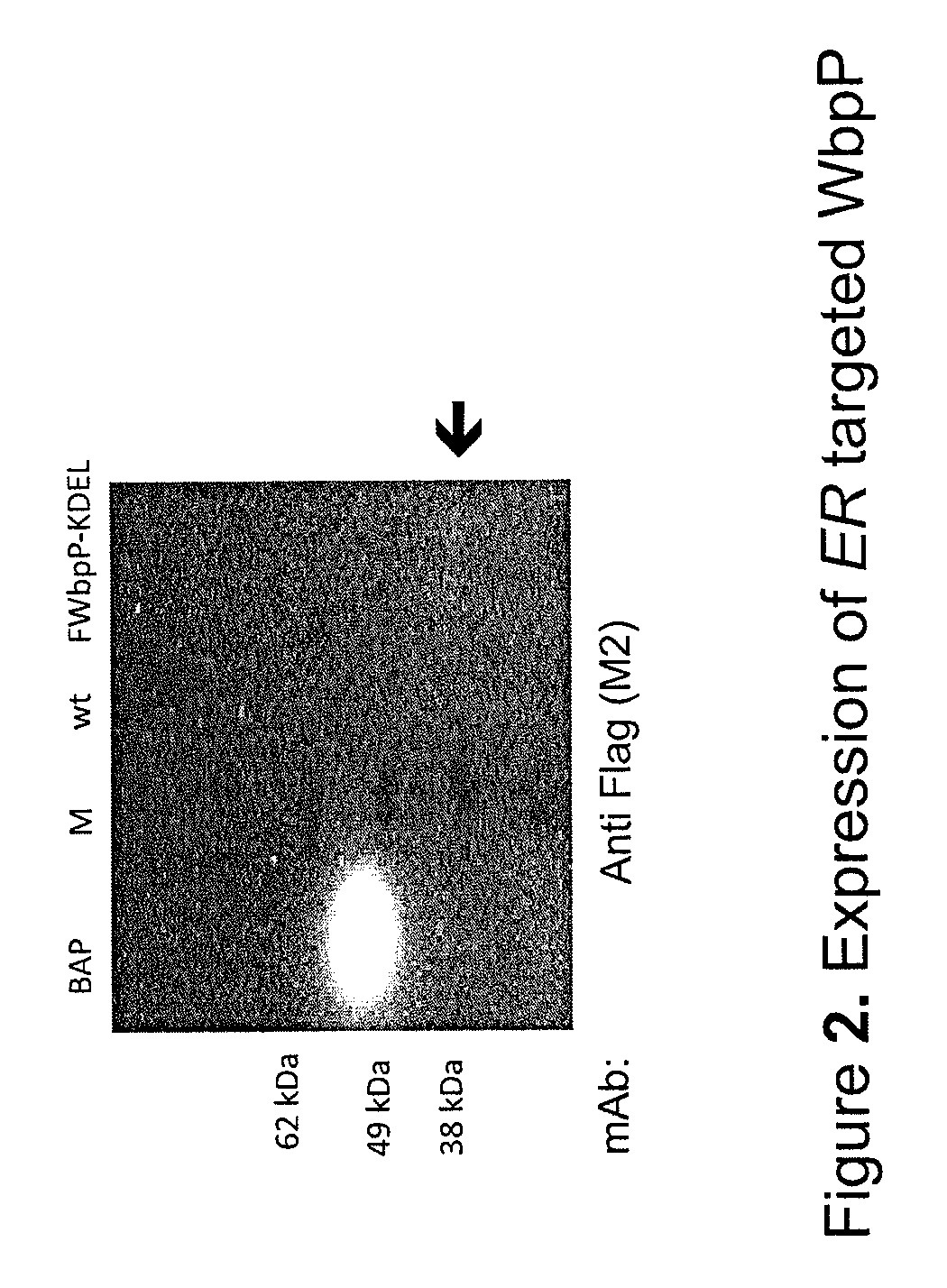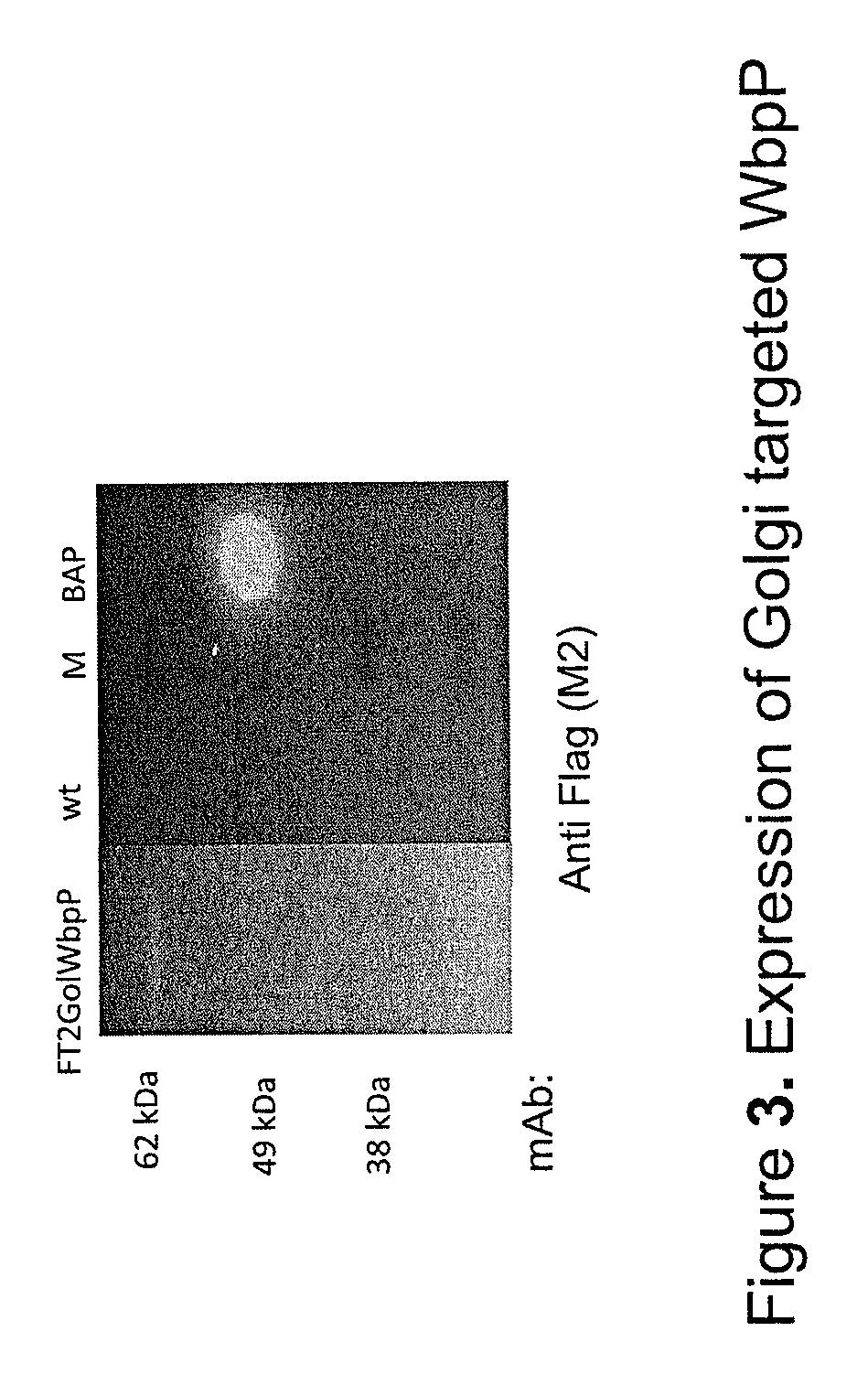Methods for glyco-engineering plant cells for controlled human O-glycosylation
a glycosylation and plant cell technology, applied in tissue culture, peptides, enzymology, etc., can solve the problems of complex and laborious definition of in vitro glycosylation status, poor homogeneous product, and high cost of nucleotide sugars
- Summary
- Abstract
- Description
- Claims
- Application Information
AI Technical Summary
Benefits of technology
Problems solved by technology
Method used
Image
Examples
example e1
Subcellular Specific Expression of P. aeruginosa C4 Epimerase (WbpP)
E1.1 Expression of Cytoplasmic WbpP
pC2300-35SPro-Fwbpp-35Sterm (C1.1)
[0163]N-terminal Flag tagged soluble epimerase (FWbpP) is expressed with the expected size (39.7 kDa) in Arabidopsis thaliana transgenic for the construct pC2300-35SPro-Fwbpp-35Sterm (C1.1).
[0164]FIG. 1. Western analysis of total proteinacious leaf derived extracts of wt and a transgenic Arabidopsis thaliana line expressing cytoplasmic N-terminally Flag-tagged WbpP (FWbpP) pC2300-35SPro-Fwbpp-35Sterm (C1.1). Primary mAb: anti Flag (DYKDDDD) M2 mAb (Sigma-Aldrich). Positive control: Flag-tagged Bovine Serum albumine Protein (BAP, Sigma-Aldrich).
E1.2 Expression of ER Targeted WbpP
pC2300-35SPro-AaSP-FwbppKDEL-35STerm (C1.2)
[0165]N-terminal Flag tagged soluble WbpP (FWbpP-KDEL) including aa N-terminal Oryza sativa alpha-amylase signal peptide (AaSP) and the C-terminal ER retention signal KDEL (FWbpP-KDEL) is expressed with the expected size (40.1 kDa) ...
example e2
Expression of Golgi Targeted GalNAc-Transferases
E2.1. Expression of Golgi Targeted GalNAc-T2
pC1302D-35SPro-T2-35STerm (C2.2)
[0169]GalNAc-T2 is stably expressed with the expected size (64.7 kDa) in Arabidopsis thaliana transgenic for the construct pC1302D-35SPro-T2-35STerm (C2.2) and GalNAc-T2 is associated with membranes (microsomal fraction) as demonstrated by Western blot analysis of total proteinacious leaf-extracts which was sub-fractionated in to a microsomal (total membrane) and soluble fraction.
[0170]FIG. 4. Western analysis of total proteinacious leaf-extracts of wt and a transgenic Arabidopsis thaliana (A) and total proteinacious leaf-extracts of transient N. bethamiana, which were sub-fractionated into a microsomal (total membrane) and soluble fraction (B) both expressing GalNAc-T2 (pC1302D-35SPro-T2-35STerm (C2.2)). Primary mAb 6B7 (anti GalNAc-T2), T.E. (Total proteinacious extracts), Sup. (Soluble fraction), Mic. (Microsomal fraction). Positive control: soluble part of ...
example e3
Expression of Enzymes Conferring Mucin-Type O-glycosylation Capacity
E3.1 Expression of Cytoplasmic FWbpP and HA Tagged Golgi GalNAc-T2 from One Polycistronic Transcript
pC1302-35SPro-HAT2-2A-FWbpP-35STerm (C3.1)
[0171]Mucin-type O-glycosylation capacity has been implemented by the polycistronic construct pC1302-35SPro-HAT2-2A-Fwbpp-35STerm (C3.1) where (HA)GalNAc-T2 (Golgi targeted) and P. aeruginosa C4 epimerase (WbpP, cytosolic), interspaced by the self splicing 2A sequence (Cf Materials and Methods), are expressed as a single polyprotein which is co-translationally spliced into the respective two functional proteins, as e.g. evidenced by stable and transient expression of pC1302-35SPro-HAT2-2A-Fwbpp-35STerm (C3.1) in A. thaliana, and N. benthamiana, respectively. (HA)GalNAc-T2 has a Hemma Agglutinin (HA) tag fused to the N-terminus of GalNAcT2.
[0172]FIG. 5. Western analysis of GalNAc-T2 and P. aeruginosa C4 epimerase (WbpP) expressed transiently in N. benthamiana from polycistronic...
PUM
| Property | Measurement | Unit |
|---|---|---|
| pH | aaaaa | aaaaa |
| volumes | aaaaa | aaaaa |
| pH | aaaaa | aaaaa |
Abstract
Description
Claims
Application Information
 Login to View More
Login to View More - R&D
- Intellectual Property
- Life Sciences
- Materials
- Tech Scout
- Unparalleled Data Quality
- Higher Quality Content
- 60% Fewer Hallucinations
Browse by: Latest US Patents, China's latest patents, Technical Efficacy Thesaurus, Application Domain, Technology Topic, Popular Technical Reports.
© 2025 PatSnap. All rights reserved.Legal|Privacy policy|Modern Slavery Act Transparency Statement|Sitemap|About US| Contact US: help@patsnap.com



